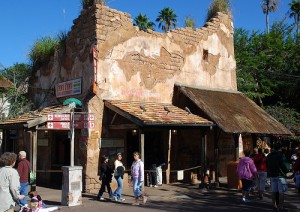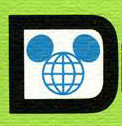by Dr. Joseph Barber
Although my postdoc was run through the University of Central Florida, I was physically based at Disney’s Animal Kingdom (DAK) – yes, that’s right, with Mickey and the gang. You might think this a strange place to do a postdoc, until you realize that my PhD is in animal behavior. There are lots of real animals at DAK, not just the giant-headed, costumed kind. Beyond my research into animal welfare, I learnt a lot from my Disney experience, and got some great insights into the corporate world of mission statements, branding strategies, marketing campaigns, and the laser-like focus that Disney has on customer service.

Let’s take the idea of “theming” as an example of some of these concepts. Yes, theming is based on the noun “theme” that, like the word “friend”, probably should not be made into a verb. But anything is possible at Disney, and so that’s what they did. If you have been to DAK you know that you walk around several different environments within the park. The two main ones are Asia and Africa – not anywhere specific in Asia or Africa, but some broad idea of what we generally envision when we think about those far-off places (or at least what Disney wants you to think). When you walk around in Africa, looking at the range of fantastic wildlife, taking the safari ride, and saving elephants from poachers, you are meant to believe that you are actually there, not just in a theme park. The design of the buildings, the type of thatched roof used, the sights, sounds, and smells that surround you as you browse the vibrant marketplace or wait in the train station, they have all been designed to help you feel that you are really there. The Disney Imagineers, those people in charge of conceptualizing and creating the Disney experience, traveled far and wide to get inspiration to use in the design of the theme park.

In Asia, you may walk through a temple as you queue for one of the rides. When the park first opened, visitors who entered some of the temple areas started to take their shoes off because they saw a pair of shoes outside of the temple that had been placed there as part of the theming. They didn’t have to, and Disney probably preferred they didn’t for liability/health and safety reasons, but they were buying into the theming. It seemed natural to take off their shoes in that environment.
Every object you see as you walk around DAK is there for a reason, and has its own story. Perhaps the shoes were owned by a local bicycle repairman who had spent the day repairing a bike that had been damaged when its owner crashed it after being chased by tigers near to the old temple ruins. OK, now we are getting to the part where Disney can help with your CV/resume. There is such a rich context to every object and every building in the park, but the Imagineers’ goal is for you not to notice them. The objects are not meant to stick out as something you need to look at and investigate, they are they to help you become immersed in the experience of actually being in Africa or Asia. The more you notice the trimmings, the less rich your experience becomes. It seems strange to for the Imagineers to spend so much time on every aspect of their design only to want them to be ignored, but they realize that people value the overall experiences that they have at the end of the day more than they value being impressed by the range of objects that they have seen. They would be impressed by the objects if they realized how much thought has gone into them, but the objects are there to become the backdrop to the immersion experience, not the main parts of it.
If you have had your CV/resume reviewed at Career Services (and we recommend that you do if you haven’t), then you have probably received feedback not only about the content (your experiences), but also about the formatting (the trimmings).
- Do you have consistent punctuation?
- Are the hyphens between your dates the same size, with the same spacing either side of them?
- Are the bullet points the same shape, and indented to the same degree throughout the document?
- Is the font used consistent, and is the size the same throughout the document?
There is a long list of formatting issues that we can look for whenever we review your job application materials. But are these really important issues? Will a misaligned bullet point really lose you the chance to interview for your dream job? Well, there are some good practical reasons to make sure your formatting is in order. If you are evenly matched in terms of experience with several candidates for a potential job, but your resume formatting isn’t perfect, then perhaps an employer can make their short list of candidates to interview by thinking about who has the greatest attention to detail. In some jobs (think editing or medical writing), attention to detail is not just a bonus, it is an essential requirement.
The Disney approach to thinking about your CV/resume helps to ensure that the employers focus on the rich experiences that you have, and the skills you have illustrated in your documents, by trying to make sure that that they don’t think about your formatting at all. Employers don’t really care about the formatting…, up until the point where they notice an issue, and then that might be all they can think about. As soon as employers start noticing formatting issues, they are no longer concentrating on your skills and experiences – these are the elements that will get you the interview. You don’t want employers to walk away from reading your resume saying, “those were some nice shapes they used in their bullet points”, or worse, “Why don’t the bullet points line up properly?”. You want them to walk away saying, “Those bullet points really illustrated how effective their analytical skills were”. You have to format your documents so impeccably that no-one even notices all of the time you spent tweaking the look of the text and proofreading for spelling/grammar mistakes. You want the formatting to become the backdrop to the content you want to get across. When employers are immersed in your skills and experiences, they will value you more. When this immersion is interrupted by a spelling mistake or misplaced comma, your theming is ruined, and the key message that you are the most suitable candidate becomes obscured.
Disney knows how to sell their brand and the experiences they offer. Career Services can help you market your own skills and knowledge for your future careers. Stop by and see us, or visit our website to see how we can help you.
Jambo everyone!



awesome blog man, I really dig your writing style that you are using for your posts and stuff, really hollywood…
Your Animal Kingdom experience served as a great way to illustrate your point on creating a good resume. When you make a resume, you are in effect marketing yourself, and Disney is one of the best marketers around. Great approach, great post.